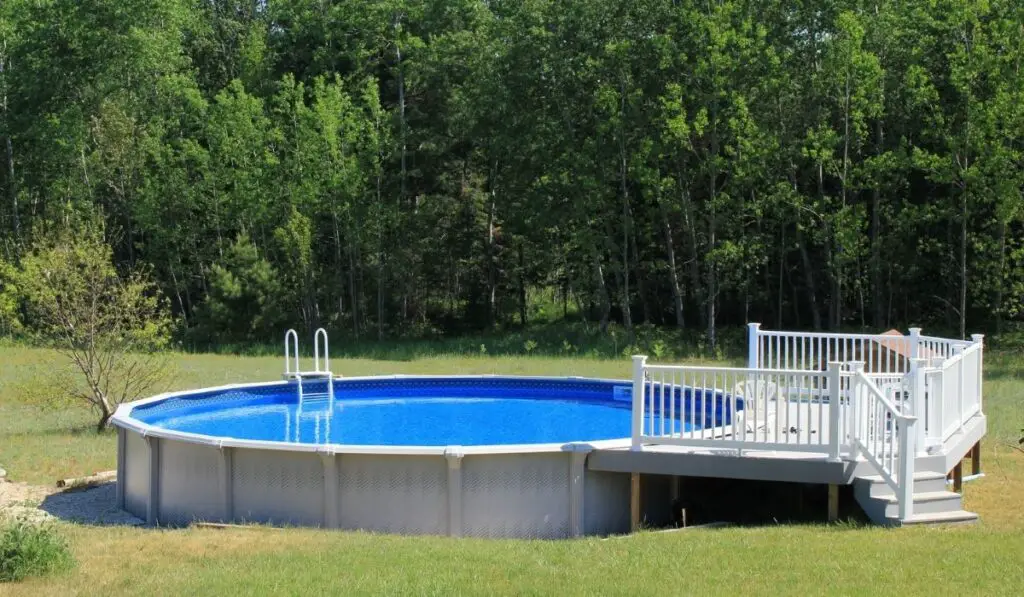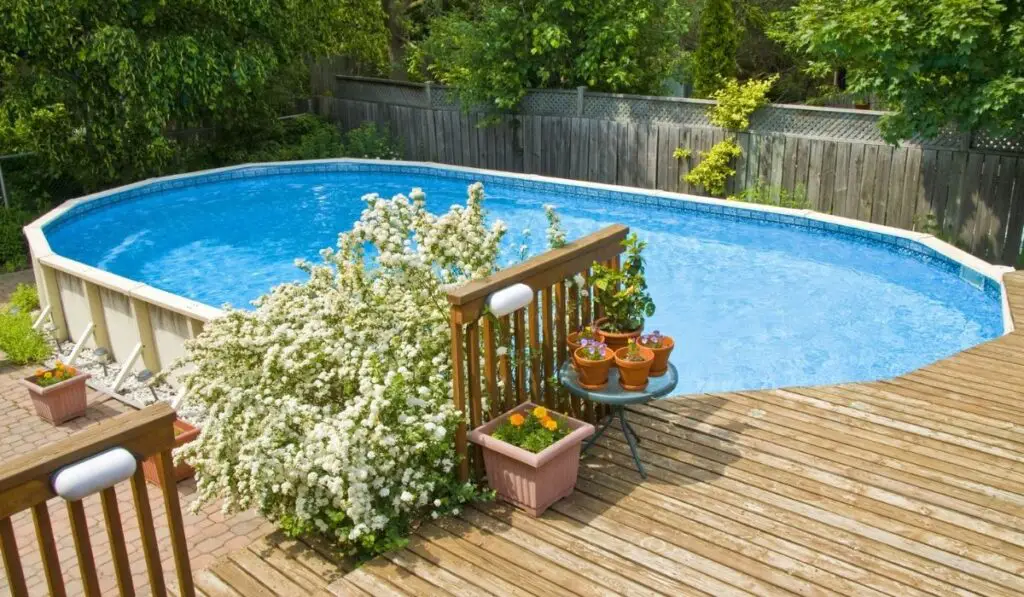Because pools can be quite expensive, people are often looking for ways to cut down on costs — and make the installation more convenient. Above-ground pools are significantly less expensive than in-ground pools, so you might be wondering if there’s some sort of shortcut where you simply bury an above-ground pool and end up with a similar result.
Unfortunately, you can’t bury your above-ground pool — at least not all the way. Burying it completely can damage the pool, as well as void any warranty you might have. Partial decking around an above-ground pool can camouflage it as an in-ground pool.
If you’re considering options for customizing your above-ground pool, let’s look at what you can do — and why you shouldn’t bury it all the way. Fortunately, there are some options for lowering the height of your pool and customizing it that don’t involve completely burying it.
What Kind of Pool Can You Bury?

If you’re looking to bury a pool, it’s best to start with a semi in-ground pool rather than trying to bury an above-ground pool. The reason for this is that a semi in-ground pool already has the structure to survive being somewhat buried, whereas an above-ground pool doesn’t have this same resilience. A semi in-ground pool has a much thicker wall.
You should know if you’re going for a semi in-ground pool, the price tag will be much steeper. If you do intend on burying your pool, however, it’s better to pay for it than risk all of the bad things that can come with attempting to bury an above-ground pool. There are structural, financial, and safety concerns, all of which are worth considering.
How Can You Partially Sink an Above-Ground Pool?
What you can do if you’re looking to bury an above-ground pool is partially sink it. This is much safer than attempting to bury it entirely and good contractors are usually much more willing to go ahead with this process.
The first thing you should do is check that there are no local and state laws prohibiting this option. Sinking an above-ground pool, even partially, requires digging into the ground, and you’ll want to make sure you have any necessary permits in place.
Some places will be just fine with you doing this and others may raise an issue, so always make sure to ask.
You should also hire contractors to do this and never do it yourself. Bear in mind, at least half of the pool will likely still rise up from the ground, and going further is so dangerous that many contractors will refuse to do it.
You should listen to the experts’ advice and make sure you check your warranty, because even partially burying the pool may void it.
What Are Some of the Risks of Burying an Above-Ground Pool?
There are many risks to burying an above-ground pool, which is why many contractors won’t even consider it. Here are some of the risks:
Cost
The cost of burying an above-ground pool can be somewhat unpredictable. It’s likely to be expensive from the start, but many things can go wrong that may add to the cost. Contractors may be unsure of just how long this will take them.
Questionable Workers
Contractors who agree to bury an above-ground pool entirely are probably not the best contractors to use. Every good contractor knows this is a risky job and should heavily advise against it, so those willing to do it may not be the professionals you can rely on.
Liners
The main risk with burying an above-ground pool is that the liners simply aren’t built to withstand the pressure the ground will create around them. If you’re lucky enough to have the installation go smoothly in the first place, it’s very likely they’ll collapse later on. This can cause huge problems, with a huge amount of water and chlorine spilling out into the ground.
Furthermore, you will eventually have to change the liner, and when you’ve buried the pool, this becomes an even bigger job. There’s a huge risk of things caving in, which will be costly to fix, and it could even cause irreparable damage.
Digging Down Is Risky
Digging down into the ground is, in itself, risky. You never know what could be down there. If you haven’t properly assessed the area, you could run into pipes that could get damaged.
If you live in a wet area, it’s also possible to run into a water source that will then flow up and over the ground. This can be damaging to the surrounding area, and you may run afoul of your local area’s water laws.
Damage to the Yard
When you bury an above-ground pool, you need a bigger hole than the pool itself. It seems like common sense, but some people don’t picture the scope of the hole that’s actually needed — and it means saying goodbye to that part of your yard.
The hole can actually end up being up to two feet larger around the edges than the pool itself.
Why Shouldn’t You Bury an Above-Ground Pool?
All in all, there are many reasons why you shouldn’t bury an above-ground pool. Let’s take a look at the main ones.
Safety
There are many safety issues with completely burying an above-ground pool. It’s not just the pool itself you’re risking, but the safety of the people using it. Just imagine what would happen if a collapse occured while people were relaxing in it!
It can also cause issues because you’re digging down into the ground and, chances are, if contractors have agreed to completely sink this pool, they may not be very knowledgeable — especially if they didn’t give you any advice against it. That means the job itself may not be done in the proper manner, and they could hit pipes or have water flow up unexpectedly.
It Will Void Your Warranty
When you bought your above-ground pool, it likely came with a warranty. That warranty probably states it will be voided if you bury the pool. Some warranties do allow for partial burying and others don’t, so if you want to sink your pool just a little, make sure you read the fine print before going ahead.
Otherwise, if you end up with damage, you’re on your own — and it’s probably going to be costly to fix.
You Will Damage Your Above-Ground Pool
Beyond the safety concerns and the warranty, it’s very likely you’ll damage your above-ground pool beyond repair by burying it. Even if you successfully get it in the ground, the next time you change out the liner, the whole thing may cave in — and since liners need to be changed out every few years, there’s nothing you can do to mitigate this risk after the process is complete.
That’s just if you make it through the backfilling process. Backfilling is another risky point, as it’s necessary to do to fill the pool with water but it’s another point in the process where the structure may collapse due to the pressure.
What to Do if You Want to Go From an Above-Ground Pool to an In-ground Pool

If you’re absolutely determined to have an in-ground pool instead of your above-ground pool, you have two main options.
The first is partial burying. If you’ve checked the warranty and you’re sure it’s allowed (or it’s not and you want it so badly you’re willing to take the risk), find some good contractors. You’ll still have to live with some of the pool being above the ground, but it’ll at least be an improvement.
The second is to install a brand new pool. The cost of this may be higher than burying the original pool, but it’s less than it might be to repair all of the damage a buried above-ground pool could cause.
